Sequoia Configuration - Pentant Gateway
Overview
The gateway handles the communication of messages between Sequoia and Pentant.
Configuration involves adding the login details required to authenticate with Pentant's system - these login details are provided by Pentant at the time of acquiring your badge code(s).
Connecting to Pentant via FTPS
As of 1st March 2022, Pentant are only supporting a connection via secure FTP (known as FTPS). Upgrading Sequoia from a version earlier than 5.01 should be seamless and require no changes. However, if you are having problems sending declarations after the upgrade, please check the following:
- The Inbound and Outbound FTP Service URIs should be fully qualified domain names, not an IP address. The Inbound FTP Service URI and Outbound FTP Service URI in the badge settings section of the Pentant gateway configuration should start with ftp://inventory.pentant.co.uk
- Active mode is not supported. Ensure Passive Mode in the application settings section of the Pentant gateway configuration is ticked.
- A firewall or proxy server could be blocking the connection. Please check with your IT department.
Setting up the Gateway
To access the gateway, navigate through Sequoia Enterprise Management in the Sequoia Configuration application and expand the Sequoia Gateway Configuration node.
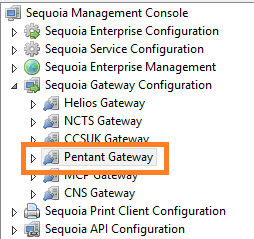
Click on Pentant Gateway and the application settings configuration page will be shown in the right-hand pane.
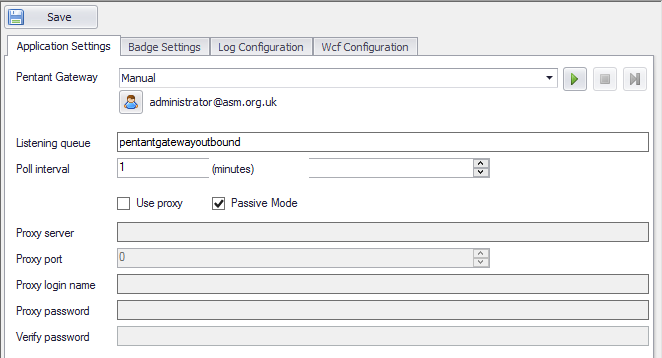
| Label | Description |
|---|---|
| Pentant Gateway | These controls indicate how the Windows service is configured. This is normally setup at the time of installation but can be changed here. The service can be stopped/started using the 'stop'  and 'play' and 'play'  buttons. buttons.The user account can be changed by clicking on the user icon  |
| Listening queue | This is the message queue that the gateway uses to send messages to Pentant. This should not be changed unless under guidance from the ASM Heldpesk. |
| Poll interval | This governs how often, in minutes, the gateway will check for messages at Pentant. The default setting is 1 minute; changing this would cause delays in receiving responses from Pentant. |
| Use Proxy | If access to the Pentant web service URI is required to go through a proxy server (you're own IT department will determine if this is the case) then enable this checkbox and complete the proxy server details below with the details obtained from your own IT department. |
| Passive Mode | At the moment only passive mode is supported so this box should be ticked. |
Configuring the Badges to use the Gateway
Each badge you have for Pentant must be configured to use the gateway. Refer to the this section for configuring badges.
Click the Badge Settings tab.
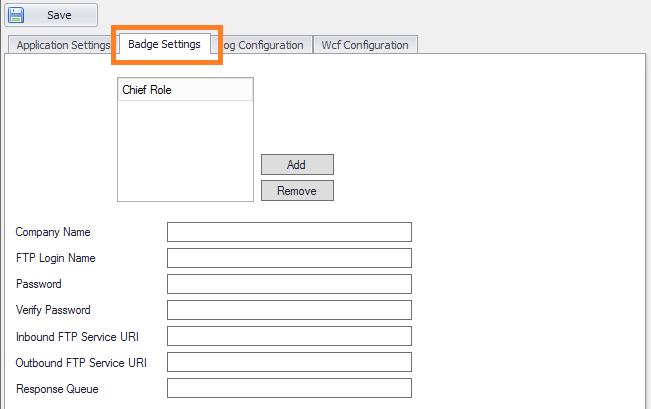
In order to assign a badge, click the Add button. This will display the Assign CHIEF Role dialog.
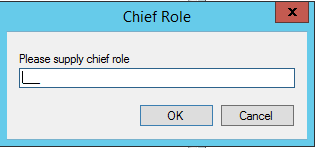
Enter the 3 letter badge code and click OK.
Once the badge has been added, the remainder of the configuration can be completed.
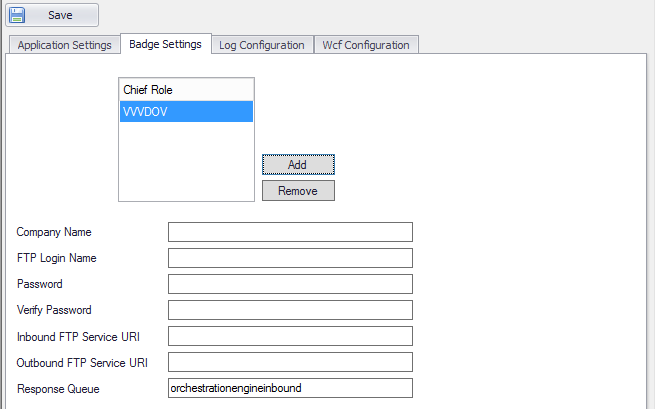
| Label | Description |
|---|---|
| Company Name | The name of the organisation operating the badge. |
| FTP Login Name | Your login name assigned by Pentant. |
| Password | Password assigned by Pentant. This is case sensitive. |
| Verify Password | As above. |
| Inbound FTP Service URI | This is the URI to connect to receive messages from Pentant. This is assigned by Pentant. |
| Outbound FTP Service URI | This is the URI to connect to send messages to Pentant. This is assigned by Pentant. |
| Response Queue | This is the message queue that the gateway uses to post the received messages from Pentant. This should not be changed unless under guidance from the ASM Heldpesk. |
Click the Save button once all details are entered.
The Windows service ASM Sequoia Pentant Gateway will need to be (re)started to use these settings.
